What is a patio heater?
A patio heater is an outdoor appliance that generates heat to keep you warm while enjoying the outdoors, even during the cold winter months. It is designed to provide heat in outdoor spaces such as patios, decks, or outdoor dining areas. Patio heaters come in different types, such as electric, natural gas, propane, and wood-burning heaters.
Electric patio heaters are the most common type of patio heater and are powered by electricity. They are usually free-standing or wall-mounted and are ideal for small outdoor spaces such as decks or balconies.
Natural gas patio heaters use natural gas as their fuel source and require a natural gas line to be installed. They are more powerful than electric heaters and are ideal for larger outdoor spaces such as outdoor patios or decks.
Propane patio heaters are powered by propane gas, which is convenient because it doesn’t require permanent installation. They are portable and can be easily moved to different areas of your patio, making them ideal for outdoor gatherings.
Wood-burning patio heaters are traditional and create a warm and cozy ambiance. They require wood as their fuel source and can be free-standing or built-in. The downside of wood-burning heaters is that they require constant attention and maintenance.
Regardless of the type of patio heater you choose, it’s critical to follow safety precautions to reduce the risk of accidents. Proper ventilation, safe clearance distances, and avoiding combustible materials are just a few ways to stay safe while using a patio heater. With the right patio heater, you can extend the use of your outdoor space and stay warm during the colder months of the year.
What is a covered porch?
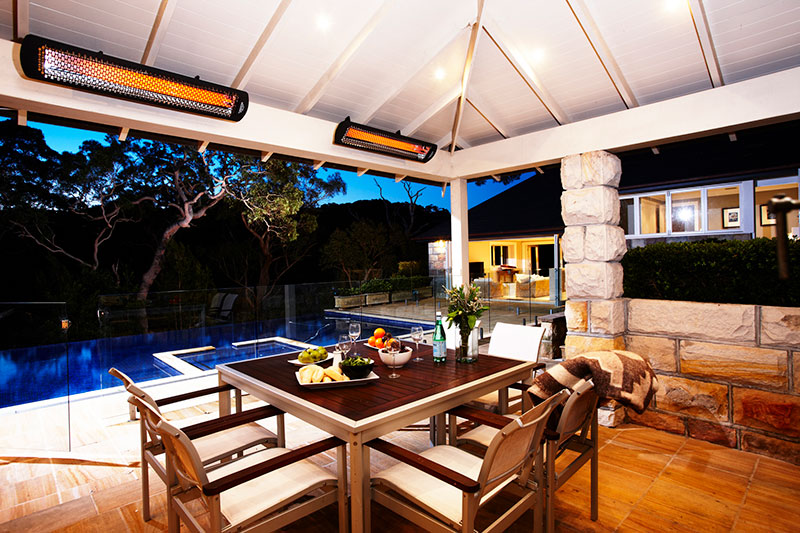
A covered porch is an outdoor space that is typically attached to a house or other structure and is covered by a roof or other type of shelter. Covered porches are commonly used as an extension of the indoor living space, allowing homeowners to enjoy the outdoors while still being protected from the elements.
Covered porches come in various styles and designs, and can vary in size and shape depending on the architecture of the surrounding building. They can be enclosed with screens or windows to provide additional protection from insects, and can be furnished with comfortable seating, lighting fixtures, and other decorative elements to create an inviting outdoor space.
One of the main benefits of a covered porch is that it can be used year-round, even during inclement weather. The covered roof provides shade during hot summer days, while also providing a dry space during rainy days. This makes covered porches a popular option for homeowners who want to enjoy the outdoors without being exposed to harsh weather conditions.
In addition to being functional, covered porches can also add aesthetic value to a home. They can be designed to match the architecture of the rest of the building, and can be furnished and decorated to create a cozy and welcoming environment.
Overall, a covered porch is a versatile and practical addition to any home. It allows homeowners to extend their indoor living space and enjoy the outdoors without having to worry about the weather. Whether you use it for relaxing, entertaining, or as a place to enjoy a cup of coffee in the morning, a covered porch is a great investment that can improve the overall quality of life in your home.
Is it safe to use a patio heater on a covered porch?

When the weather turns chilly, many homeowners turn to patio heaters to extend their outdoor living season. But if you have a covered porch, you may wonder if it’s safe to use a patio heater in that space. After all, a covered porch can provide shelter from the wind and rain, but it can also trap heat and create potentially dangerous conditions.
The short answer is that it can be safe to use a patio heater on a covered porch, but you need to take certain precautions to ensure that you’re using the heater properly and that you’re not putting yourself or your property at risk.
The type of patio heater you choose is an important consideration. Natural gas and propane heaters are popular options because they provide a lot of heat quickly, but they also create the potential for carbon monoxide poisoning if they’re not properly vented. Electric heaters are another option, but they may not provide as much heat as gas-powered models.
No matter what type of patio heater you choose, it’s important to follow the manufacturer’s instructions and all applicable safety guidelines. This may include maintaining a certain distance between the heater and any combustible materials, such as cushions or curtains, and ensuring that the heater has adequate clearance above and around it.
You should also be aware of any local regulations that may apply to the use of patio heaters, such as minimum clearance requirements or restrictions on the use of certain types of heaters or fuel types. Additionally, consider the overall design of your covered porch and whether it allows for proper ventilation and airflow.
By taking these safety measures and using common sense, you can enjoy the warmth and comfort of a patio heater on your covered porch without putting yourself or your home in jeopardy. Just be aware of the potential risks, and take steps to mitigate them, so that you can relax and enjoy your outdoor space all year long.
Types of Patio Heaters
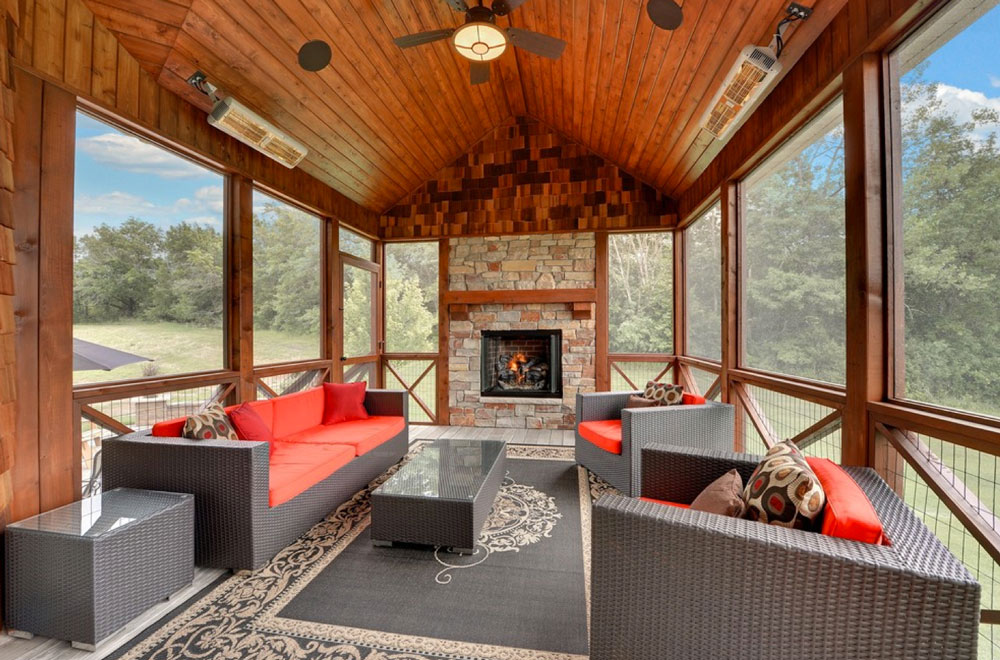
When it comes to choosing a patio heater, there are several types to consider. Each type has its own benefits and considerations, so it’s important to understand the differences before making a purchase.
1. Natural Gas Patio Heaters
Natural gas patio heaters connect directly to your home’s natural gas line, making them a convenient option for those who want a permanent heating solution. They are typically more powerful than propane heaters and can effectively heat a larger outdoor space. However, they require professional installation, which can be costly.
2. Propane Patio Heaters
Propane patio heaters are a popular option because they are portable and easy to use. They typically come with a propane tank that can be refilled or exchanged for a new one when empty. They’re available in freestanding and tabletop models, making them versatile and easy to move around. However, propane heaters can be more expensive to operate than natural gas heaters.
3. Electric Patio Heaters
Electric patio heaters are a convenient and safe option for those who don’t want to deal with gas tanks. They’re available in wall-mounted, ceiling-mounted, and freestanding models, and are capable of heating small to medium-sized outdoor spaces. They’re also energy-efficient and easy to use, but they may not provide as much heat as gas-fired models.
4. Infrared Patio Heaters
Infrared patio heaters use radiant heat technology to warm up people and objects instead of the air. They’re available in electric and gas-powered models and are generally more efficient than traditional heaters because they don’t waste energy heating up the surrounding air. They’re also considered a safer option because they don’t emit harmful fumes or require an open flame.
5. Wood-Burning Patio Heaters
Wood-burning patio heaters are a traditional option that can add a rustic touch to your outdoor space. They require manual labor and a constant supply of firewood, but they’re a cost-effective way to heat up your outdoor area. However, they’re not as convenient as gas or electric heaters and may not be allowed in all areas due to fire code restrictions.
In summary, there are several types of patio heaters to choose from, each with their own benefits and considerations. It’s important to weigh your options and choose the heater that best suits your needs and preferences. Always follow safety guidelines and manufacturer instructions to ensure proper usage and prevent accidents.
Electric Patio Heaters

Electric patio heaters are an excellent option for those who want a safe and convenient heating solution for their outdoor spaces. These heaters are easy to use and require no ventilation or fuel storage, making them an environmentally-friendly option. They’re also highly efficient and capable of producing a significant amount of heat, making them an ideal choice for those who love to entertain guests or spend time outside during the winter months.
One of the best things about electric patio heaters is the variety of models available. Wall-mounted, ceiling-mounted, and freestanding models are all common types, allowing you to find one that suits your specific needs and fits your outdoor space perfectly. Freestanding models come in different shapes and sizes, including mushroom and pyramid-shaped models, and can be placed anywhere in your outdoor space without requiring permanent installation.
Another advantage of electric patio heaters is their ease of use. With just a push of a button, you can turn on the heater and start enjoying its warmth. These heaters are also virtually maintenance-free, requiring no cleaning, fueling, or adjusting, which makes them an excellent option for those who want a heating solution that’s easy to use and hassle-free.
When it comes to safety, electric patio heaters are one of the safest options available. Since they don’t use gas or open flames, there’s no risk of carbon monoxide poisoning or combustion hazards. However, it’s still important to observe proper clearance requirements and keep combustible materials away from the heat source to keep your outdoor space safe.
In summary, electric patio heaters are an excellent option for anyone looking for a safe, efficient, and convenient way to heat up their outdoor spaces. With a wide range of models available, ease of use, and safety, they’re a popular choice for anyone looking to enjoy their outdoor spaces during the colder months.
Natural Gas Patio Heaters
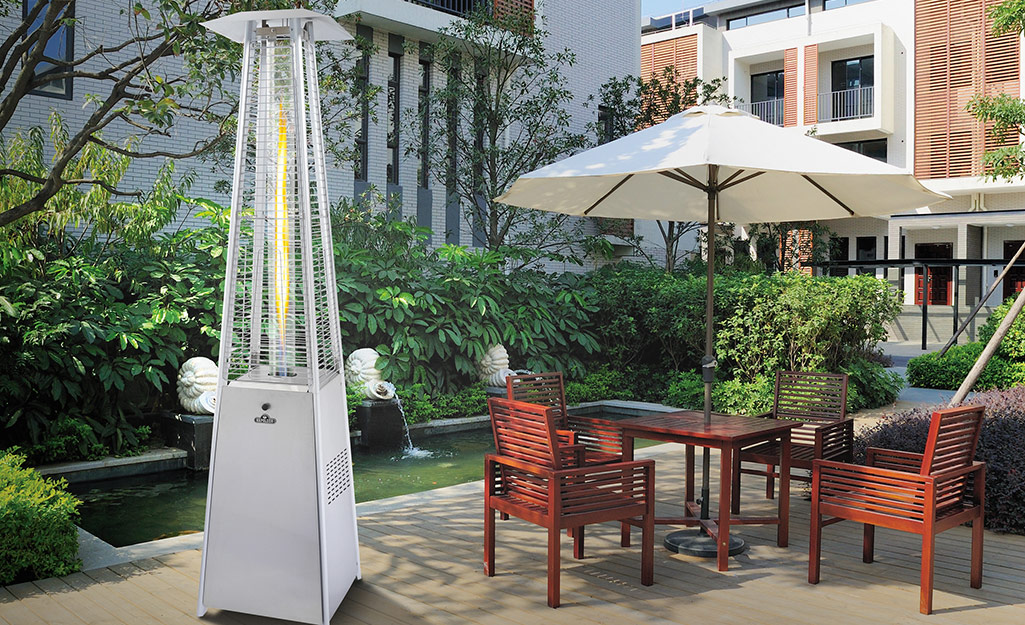
Natural gas patio heaters are becoming increasingly popular for outdoor spaces. They utilize a steady and efficient flow of natural gas to provide a consistent and powerful heat source, making them perfect for cold winter months, or for outdoor gatherings during cooler weather conditions.
One of the main advantages of natural gas patio heaters is that they are a permanent heating solution. They use an existing natural gas line, eliminating the need for regular refueling or changing of propane tanks. This makes them a great investment for homeowners looking for a long-term heating solution for their outdoor space.
Another advantage of natural gas patio heaters is that they provide a high-heat output, making them ideal for larger outdoor spaces. They are also available in a range of sizes and styles, from free-standing heaters to wall-mounted and even table-top models, so there’s sure to be a model that meets your specific needs.
When it comes to safety, natural gas patio heaters are considered a safe option since they don’t emit any fumes or create any combustion hazards. However, it’s essential to ensure proper ventilation and safe clearance from combustible materials to minimize safety risks.
In terms of maintenance, natural gas patio heaters require little upkeep. However, it’s still important to schedule an annual inspection by a professional to ensure your heater is functioning safely and efficiently.
Ultimately, natural gas patio heaters are an excellent investment for homeowners seeking a reliable, powerful, and long-term heating solution for their outdoor space. Whether it’s for hosting outdoor parties or simply enjoying a cozy evening outside during the winter months, a natural gas patio heater will provide the perfect amount of warmth to keep you comfortable.
Propane Patio Heaters
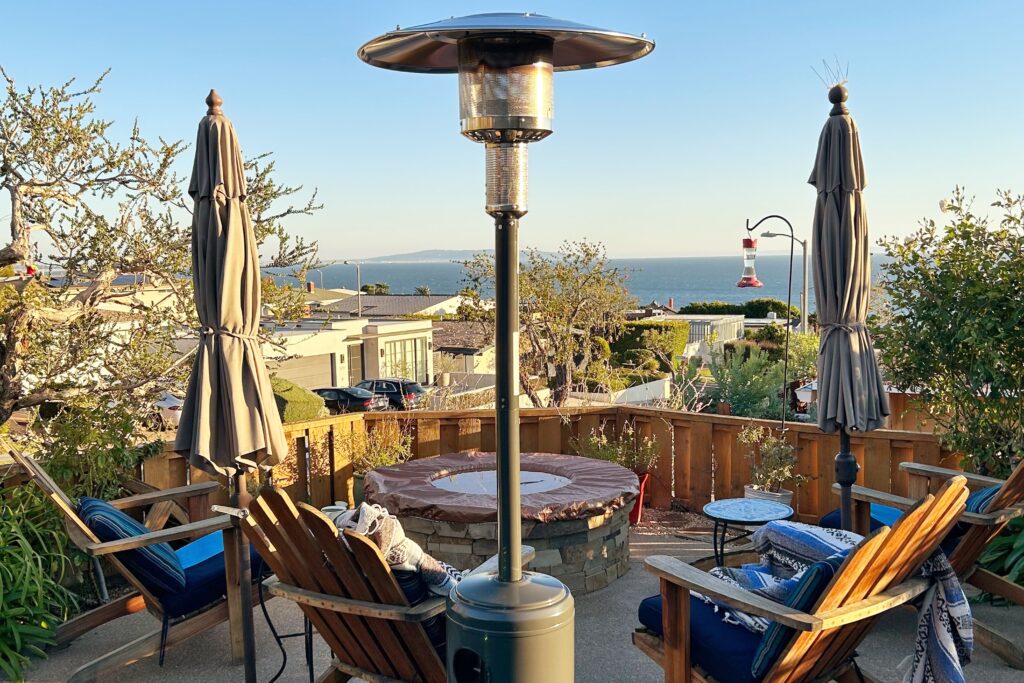
Propane patio heaters are a popular choice for homeowners who want to enjoy their outdoor spaces even during chilly weather. Unlike natural gas heaters, propane heaters don’t require a permanent gas line connection, making them a more versatile option that can be moved around to suit your changing needs.
One of the main benefits of propane patio heaters is their portability. These heaters usually come in standing models, so they can be easily moved around your patio or deck as needed. Some models are also designed to be lightweight for even greater mobility.
Propane patio heaters are perfect for keeping your outdoor space warm and comfortable during the winter months. These heaters provide a high-heat output and can be used to heat larger outdoor spaces, making them ideal for hosting parties and outdoor gatherings.
When considering propane patio heaters, it’s important to keep cleanliness in mind. Propane is a flammable gas, so it’s essential to keep your heater clean and free of any debris that could cause a fire hazard. Most propane patio heaters come with a protective cover that helps keep them clean and free of debris when not in use.
It’s also important to take proper safety precautions when using propane patio heaters. These outdoor heaters should always be placed on a stable and level surface, and should never be used in enclosed spaces like screened-in porches or tents. It’s also essential to keep the heater away from any flammable materials, and to maintain a safe clearance distance from walls, furniture, and other objects.
Propane patio heaters can be a great investment for homeowners who want to get the most out of their outdoor space. With proper maintenance and safety precautions, these heaters can provide a comfortable and inviting atmosphere for outdoor activities all year round.
Wood-Burning Patio Heaters

Wood-burning patio heaters are a great choice for those who want to add warmth and ambiance to their outdoor space. These heaters provide a rustic and traditional feel that many people find appealing, and they are often made from high-quality materials like stainless steel or cast iron.
One of the advantages of wood-burning patio heaters is that they are very cost-effective. Unlike propane or natural gas heaters, these heaters do not require any fuel except for the wood that you burn. This means that you can save money on your heating costs in the long run and enjoy the beauty of a real wood fire at the same time.
Another benefit of wood-burning patio heaters is that they are environmentally friendly. Unlike propane heaters, which emit greenhouse gases and other pollutants into the atmosphere, wood-burning heaters are completely natural and do not contribute to air pollution. Plus, the wood you burn can be sourced sustainably, making it a great choice for eco-conscious homeowners.
However, it’s important to keep in mind that wood-burning patio heaters do require a bit more maintenance than other types of heaters. You’ll need to clean the ashes out of the heater after each use, and you’ll also need to make sure that you have enough firewood on hand to keep the heater going throughout the night.
Overall, wood-burning patio heaters are a great choice for those who want a classic and traditional way to heat their outdoor space. With proper maintenance and care, these heaters can provide warmth and comfort for years to come. Just make sure to invest in a high-quality model and follow all safety precautions, such as keeping a safe clearance distance from combustible materials and ensuring proper ventilation.
Portable Patio Heaters
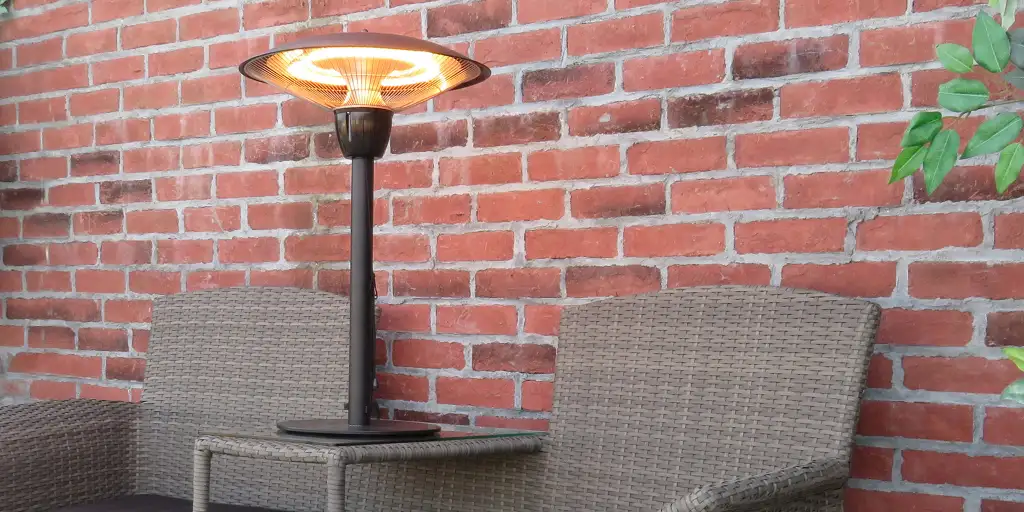
Portable patio heaters are an excellent solution for those who want to enjoy their outdoor spaces throughout the year. Whether you’re sitting on your patio during the winter months or having a late-night dinner with friends outside, a portable patio heater can keep you warm and comfortable.
One of the benefits of a portable patio heater is that it can be moved around easily. You can place it wherever you want in your outdoor space to target the area where you want direct heat. This makes it a versatile option for those who have different seating arrangements in their patio space.
Portable patio heaters come in a variety of sizes and styles, ranging from small tabletop heaters to larger freestanding models. Tabletop heaters are great for smaller spaces or intimate gatherings, while freestanding heaters are perfect for large patios or outdoor spaces with multiple seating areas.
When choosing a portable patio heater, consider the type of fuel it uses. Some models are electric, while others use natural gas or propane. Electric heaters are convenient because you don’t have to worry about filling a tank or running gas lines. However, they do require access to an electrical outlet and may not be as powerful as gas heaters.
Natural gas and propane heaters are more powerful and can heat larger areas. They also offer the advantage of being able to operate even during power outages. However, it’s important to ensure proper ventilation and clearances when using gas heaters to avoid the risk of carbon monoxide poisoning.
Another key factor to keep in mind when using portable patio heaters is safety. Always follow the manufacturer’s instructions for safe use, including minimum clearance requirements and safe distance from combustible materials. Never leave a portable patio heater unattended or use it in an enclosed space like a screened-in porch.
Overall, a portable patio heater is a worthwhile investment for anyone who wants to extend their outdoor living season. With many options available, you’re sure to find a model that fits your space, style, and heating needs.
Safety Considerations for Using Patio Heaters on Covered Porches
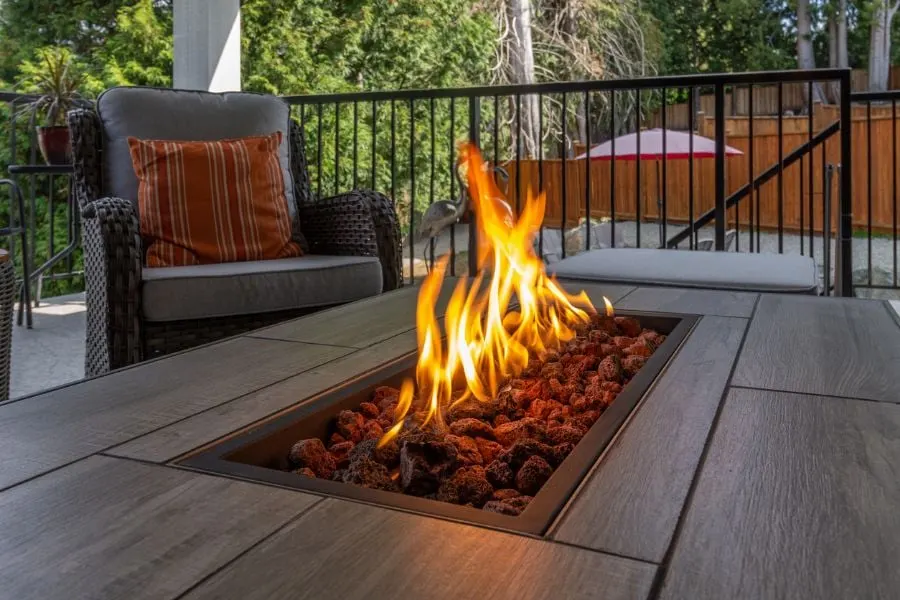
Having a covered porch can provide a cozy outdoor space to gather in, even during the cooler months. But it’s important to consider safety measures when using any type of heat source in this area, including patio heaters.
Before using a patio heater on a covered porch, the first thing to check is the clearance requirements. Most manufacturers recommend a safe clearance of at least 18-24 inches from the top of the heater and sides to any combustible materials such as furniture, curtains, or plants. Overhead clearance is also crucial, with at least 7 feet of clearance being recommended to avoid fire hazards.
Another essential safety consideration is proper ventilation. While using a patio heater on a covered porch provides some protection from the wind, it’s still important to ensure that there’s enough airflow to prevent the buildup of dangerous carbon monoxide. Keep in mind that enclosed areas, such as screened-in porches or sunrooms, are not suitable for patio heater use as they can trap carbon monoxide and cause a serious safety hazard.
Different types of patio heaters have specific safety requirements to consider as well. For example, for natural gas heaters, it’s important to have a safety shut-off valve and also ensure that there are no gas leaks. For units that use liquid propane tanks, ensure that the tank is secure and stable to avoid tipping over.
It’s essential to also follow safety precautions when using the heater. Never leave a patio heater unattended, especially when there are children or pets around. Always turn off the heater when leaving the area. Be sure to keep a fire extinguisher nearby and inspect the heater and fuel source regularly to ensure they are in good condition.
In summary, using a patio heater on a covered porch involves taking crucial safety measures to avoid hazards. Adequate ventilation, proper clearance, stable fuel tanks, and safe use are all essential to avoid fires, carbon monoxide poisoning, and other risks. By following these safety guidelines, you can enjoy a warm and cozy ambiance without compromising your safety.
Clearance Requirements for Combustible Materials and Objects
When setting up a patio heater for use on a covered porch or other outdoor space, it’s essential to consider the clearance requirements for combustible materials and objects. These requirements help to prevent fires and keep you and your guests safe while enjoying the warmth and ambiance of your patio heater.
Most manufacturers recommend a safe clearance of at least 18-24 inches from the top and sides of the heater to any combustible materials or objects. This includes items such as furniture, curtains, plants, and any other materials that could potentially catch fire or melt from the heat of the patio heater.
It’s important to carefully assess the area where you plan to use your patio heater and identify any potential hazards or combustible materials that may be present. If you’re unsure about what objects or materials may pose a fire risk, it’s a good idea to consult with an expert or seek advice from the manufacturer of your patio heater.
In addition to the clearance requirements for combustible materials, it’s also crucial to consider the overhead clearance needed for the patio heater. Most experts recommend a minimum of 7 feet of clearance from the top of the heater to any overhead structures such as awnings, patio covers, or tree branches.
Proper ventilation is also critical when using a patio heater on a covered porch or other enclosed space. The buildup of carbon monoxide from patio heaters can be dangerous and even lethal in certain situations. To prevent carbon monoxide buildup, ensure that there is adequate ventilation in the area where you plan to use your patio heater. This means keeping windows and doors open and avoiding the use of patio heaters in enclosed spaces like screened-in porches or sunrooms.
In summary, taking the necessary precautions for clearance requirements for combustible materials and objects is essential when using a patio heater in any outdoor space. By following these guidelines, you can minimize the risk of fire and enjoy the warmth and ambiance of your patio heater safely.
Adequate Ventilation for Carbon Monoxide and Other Gases
Adequate ventilation is crucial when it comes to preventing the buildup of carbon monoxide and other gases in enclosed spaces. Carbon monoxide is an odorless, colorless gas that can be deadly when its levels rise too high, and it is often produced by fuel-burning appliances such as portable heaters, fireplaces, and gas stoves.
In addition to carbon monoxide, other harmful gases and pollutants such as nitrogen dioxide, sulfur dioxide, and volatile organic compounds (VOCs) can accumulate in indoor spaces and cause a range of health problems. These pollutants can come from sources such as household cleaning products, tobacco smoke, and outdoor pollution that has infiltrated the home.
The best way to prevent the buildup of harmful gases and pollutants is to ensure that there is a constant flow of fresh air into and out of the enclosed space. This means opening windows and doors, installing vents and fans, and keeping the area well-ventilated during all times of the year.
When it comes to using fuel-burning appliances such as portable heaters or gas grills, it’s especially important to ensure that there is adequate ventilation to prevent carbon monoxide buildup. This means avoiding using these appliances in enclosed spaces like garages or basements, and instead using them in well-ventilated outdoor areas.
It’s important to note that while ventilation is crucial for preventing the buildup of harmful gases and pollutants, it’s not a complete solution. It’s also important to properly maintain and service fuel-burning appliances, ensure that chimneys and flues are clear, and follow all safety guidelines and instructions provided by the manufacturer.
In conclusion, adequate ventilation is key when it comes to preventing the buildup of harmful gases and pollutants in indoor spaces. By ensuring that there is a constant flow of fresh air and avoiding the use of fuel-burning appliances in enclosed spaces, you can protect yourself and your loved ones from the dangers of carbon monoxide and other harmful gases.
Avoid Heat Sources with Low Clearance Requirements
When it comes to adding warmth and ambiance to your outdoor patio or covered porch, there are plenty of options available. From free-standing patio heaters and propane fire pits to electric infrared heaters and portable mushroom heaters, there’s a type of heater to suit every need and budget.
However, it’s important to be mindful of the clearance requirements for each type of heater. Clearance refers to the amount of space that needs to be left between the heater and any nearby combustible materials, such as wood, fabric, or plastic.
Low clearance requirements can be dangerous if not properly accounted for, as they increase the risk of fires and other safety hazards. Therefore, it’s essential to always choose heat sources that have safe clearance requirements and to ensure that they are installed and used correctly.
One common type of outdoor heater that can have low clearance requirements is the tabletop heater. These heaters are small and portable, and can easily be placed on a tabletop or other flat surface. While they do provide significant heat output, they often have low clearance requirements that can make them a fire hazard if used improperly.
Similarly, wall-mounted patio heaters are another type of heat source that can have low clearance requirements. These heaters are designed to be mounted to a wall or ceiling, which means that they can be elevated off the ground. However, if not installed correctly, they can pose a safety hazard due to their close proximity to combustible materials.
If you are considering purchasing a patio heater or other outdoor heat source with low clearance requirements, it’s important to carefully read the product specifications and installation instructions. Ensure that you have enough space to operate the heater safely, and that there is no risk of combustible materials coming into contact with the heat source.
Remember, safety should always be the top priority when using outdoor heaters. By taking the time to choose heat sources with safe clearance requirements and following all safety guidelines, you can enjoy the warmth and comfort of your outdoor space without putting yourself or others at risk.
Ensure the Unit is Approved for Outdoor Use
Outdoor spaces can be a great way to enjoy the fresh air and spend time with loved ones. However, when the temperature drops, being outdoors can be uncomfortable. That’s where outdoor heaters come in handy. They can provide warmth and comfort to your outdoor space, making it an inviting place for you and your guests. But before you purchase an outdoor heater, make sure that the unit you intend to buy is approved for outdoor use.
Not all heaters are created equally. Some are intended for indoor use only and can be dangerous if used outside. If you use an indoor heater outside, you run the risk of it malfunctioning or even causing a fire. This is why it’s important to choose a heater that is specifically approved for outdoor use.
When shopping for outdoor heaters, look for the label that indicates the unit has been approved for outdoor use. This label is usually located on the packaging or on the heater itself. This labeling ensures that the unit meets the safety standards required for outdoor use.
An outdoor heater is designed to withstand outdoor conditions, such as wind, rain, and snow. These units are often made of durable materials and have a protective coating that prevents rust and corrosion. In addition, outdoor heaters have safety features that are specifically designed to prevent fire hazards in outdoor environments.
Using a heater that is not approved for outdoor use can be a danger not only to you and your loved ones but also to your property. Always ensure that the unit you purchase has been approved for outdoor use to minimize the risk of accidents or damage.
In summary, if you’re looking to purchase an outdoor heater, make sure that the unit you choose is approved for outdoor use. Check for the labeling on the packaging or product itself, and carefully review the instructions to ensure that you are using the unit properly. By doing this, you can enjoy the warmth and comfort of your outdoor space without any safety concerns.
Install/Set Up Per Manufacturer’s Instructions
When it comes to installing or setting up any product, it is important to follow the manufacturer’s instructions. This is particularly crucial when setting up appliances or items that require electrical work, as incorrect installation can result in serious safety hazards.
Before beginning any installation or set up process, it is important to thoroughly read the manufacturer’s instructions. These instructions will provide step-by-step guidance on how to properly install or set up the product, as well as any safety precautions that should be taken. This information may include specific tools needed, proper positioning or mounting instructions, and recommended clearances or distance from other objects.
Ignoring or overlooking the manufacturer’s instructions can result in faulty installation or improper use of the product. This can lead to product malfunction, damage to the item or surrounding property, and even serious injury or harm.
It is also important to note that failure to follow the manufacturer’s instructions can result in voiding any warranties or guarantees that may come with the product. This means that if the product malfunctions or fails due to incorrect installation or use, the manufacturer may not be held responsible and any repair or replacement costs will fall on the consumer.
In order to ensure proper installation and use of any product, taking the time to read and follow the manufacturer’s instructions is crucial. This not only ensures the safety of yourself and your property, but also ensures the long-term functionality and effectiveness of the product.




